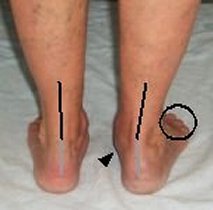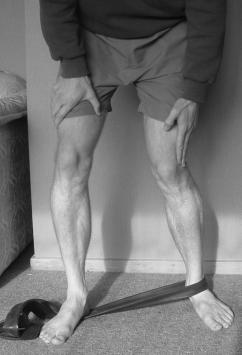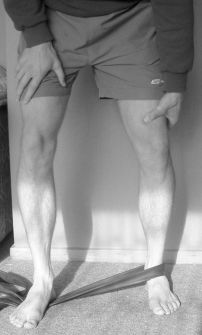
|
If you have Tibialis Posterior Tendonitis, be aware that there is nothing deficient about your
Tibialis posterior tendon or muscle....
The real problem is that the
Posterior Tibial tendon and muscle are being overloaded by
faulty patterns of
leg alignment and muscle tensioning.
If Tibialis Posterior Rehab is to work, you must correct these things.
(<<< See Page 1 for Explanation of Picture)
|

About the Author...

Why donate?
PayPal Membership No Longer Required!
|

Table of Contents
Page 1: Tibialis Posterior Tendonitis Rehab: Introduction
Page 2: Posterior Tibial Insufficiency Treatment (1): Leg Realignment
(<<< You are here)
Page 3: Posterior Tibial Insufficiency Treatment (2): Exercises
Page 4: Posterior Tibial Tendonitis Treatment: Trigger Point Massage
Page 5: Posterior Tibial Insufficiency Treatment
(4): Postural Realignment Made Easy!
Contents, this page
Leg Re-alignment Setup
Posterior Tibial Realignment Strategy Part 1:
Contracting the Posterior Tibial Muscle
Posterior Tibial Realignment Strategy Part 2:
Correcting the Knock Kneed Stance
Posterior Tibial Realignment -
The Less Than Ideal Strategy Of Orthotics To Lift The Foot Arch
Retraining of Leg Alignment - Not An Easy Task!
Leg Re-alignment Setup
(Use a bicycle inner tube):
Loop the tube around the outside
of the ankle that requires correction of alignment, and tension the tube a little such
that it pulls the foot into the position of maximum stretch in the Tibialis posterior.
If we can now find a leg alignment strategy that easily overcomes the pull of the rubber
tube, then we know that we are onto a winner!
Note that the knees are slightly bent, and that the knee of the test leg is being held
in the knock kneed position described in part 1 of this article.
| |
Picture 7

|
Posterior Tibial Realignment Strategy Part 1:
Contracting the Posterior Tibial Muscle
|
- Place fingers on the outside of the knee to stop it moving to the side.
- Contract the Tibialis posterior muscle.
The ankle pulls back against the rubber tubing, but the foot arch is still only partially
raised off the ground. Note that this is the situation in a healthy, fully functional
lower leg and foot. In the situation for an already over strained and insufficient tibialis muscle,
the foot arch would not lift even this much. The standard reply to this situation
is "We'll easily fix that - just put in an orthotic. That will raise and correct
the fallen foot arch". But there is a problem with putting an orthotic under
this foot arch, as will be explained later in this article.
| |
Pictures 8 and 9


|
Posterior Tibial Realignment Strategy Part 2:
Correcting the Knock Kneed Stance
|
1. Form foot arch as in "Realignment Strategy Part 1".
2. Place the fingers inside of the knee,
and encourage the knee to move to the side.
The femur thus laterally rotates to catch up with the lateral rotation in the tibia,
and the knee is no longer twisted. Note how the foot arch fully lifts by combining
the twin strategies of contracting the Tibialis posterior muscle and moving the knee laterally.
| |
Pictures 10 and 11:
The double strategy of raising the foot arch and correcting the
knock kneed stance is depicted.


|
Posterior Tibial Realignment:
The Less Than Ideal Strategy Of Orthotics Alone To Lift The Foot Arch
|
Pictures 11 and 12: Forming the foot arch (for example by use of orthotics) without
correcting the "knock kneed" femur rotates the tibia outward (circular arrow), and creates
an extra twist at the knee (indicated by the increase in the angle of the line over the
patella tendon).
Comments
Correcting the Tibialis posterior fallen foot by orthotics alone merely shifts the
alignment problem further up the leg to the knee. With orthotics as a stand alone
treatment, the Tibia has rotated laterally, but the thigh bone remains stationery
in its "knock kneed" state (adducted and medially rotated), thus putting a twist
on the knee that strains knee ligaments and cartilages, and also deactivates the
balancing action of the vast medial oblique muscle. Torn knee cartilages, patellofemoral
syndrome and Popliteus muscle strain will follow(*). A full correction strategy for Tibial
insufficiency may require use of orthotics (and even bracing of the ankle), but must also
involve the realignment of the thigh bone (as has just been described).
(*) Cinical Evidence for excessive lateral tibial rotation causing knee pain:
Strained knee cartilages: The author developed pain on the inside of his knees as the result of
a skating kick that put the tibia into lateral rotation. Avoidance of excessive lateral tibial rotation,
when combined with a full lower body stretching program corrected this pain over a period of 4 months.
Popliteus Muscle Strain: A semi professional footballer developed pain behind the knee as a result of
very agressive orthotics which to him felt like he was walking on high heeled shoes. Unfortunately,
I did not at that time have sufficient knowledge to explain to him the dangers of excessive lateral
tibial rotation.
| |

|
Picture 11
Ankle alignment alone corrected. Note the twist that occurs at the knee.
|

|
Picture 12
Knee and ankle alignment corrected together. There is no longer a twist at the knee.
|
|
Retraining of Leg Alignment - Not An Easy Task!
|
In the healthy individual with a full team of fully functional leg muscles, the twin
strategy is easily performed. However, in the patient with a Posterior Tibial insufficiency,
there may have been a whole life time of dysfunctional leg muscles usage. Training
these muscles to become active will not be easy. The muscles that require activating
are the buttock muscles (the gluteal muscles and the deep hip external rotators), and the
Vastus medialis (part of the Quadriceps group). It takes diligence to retrain theses muscles. The Joseph Pilates exercise system
(by use of the twin concepts of
"Pilates Point" and "Pilates Stance") - is extremely good at activating these muscles.
Go along to a Pilates mat class where these concepts are taught!
Tight muscles on the lateral side of the leg (Biceps femoris,
Vast lateral and Tensor fascia lata, Gluteus minimus) must be encouraged to relax
and lengthen too. Picture 13 describes how these muscles can be relaxed.
| |

Picture 13: The fingers are placed on the Biceps femoris to monitor and prevent
it working too strongly. (Excessive tension in the biceps femoris laterally rotates
the tibia beyond what is safe for the knee joint).
|
The next section covers exercises for the Correction of Alignment. Once the leg alignment
is corrected, the Tibial Tendonitis/Insufficiency will gradually correct by itself.
Don't get too serious about what follows.
Just relax and have a play! You've had the pain, now start looking for the gain.
|
|
|
Return to top...

Tibialis-posterior Rehabilitation © Bruce Thomson EasyVigour Project

|